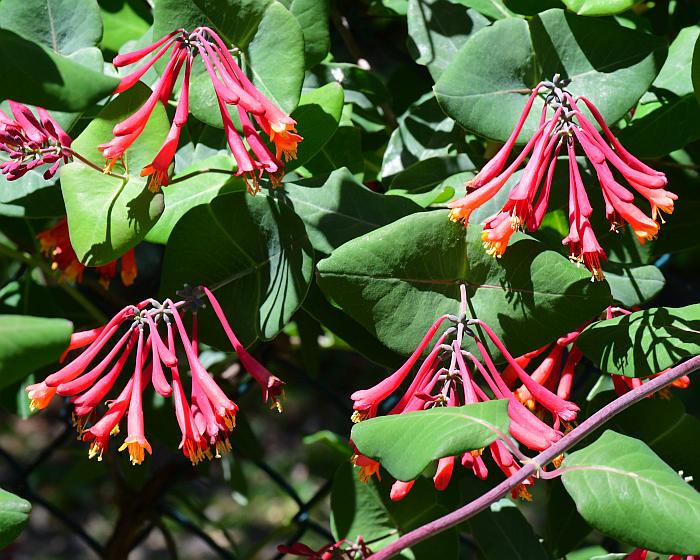Lonicera sempervirens L.
Trumpet Honeysuckle

Introduced
CC = *
CW = 3
MOC = 28
© SRTurner
Lonicera sempervirens L.Trumpet Honeysuckle | |
 |
Introduced CC = * CW = 3 MOC = 28 |
© SRTurner |
|
Family - Caprifoliaceae Habit - Perennial liana. Stems - Climbing, twining, or trailing, to 4 m, glabrous, with hollow pith. Older branches with shredded bark. Winter buds conical, glabrous.
Leaves - Opposite, simple, petiolate. Leaf blades mostly 3.0-7.5 cm long, 1.5-4.5 cm wide, oblanceolate to oblong-elliptic to ovate, angled or tapered at the base, usually bluntly pointed at the tip, those of the uppermost 1 or few pairs strongly perfoliate, 1.2-2.8 times as long as wide, the pair broadly elliptic to oblong-elliptic in overall outline, rounded or broadly angled to usually bluntly pointed tips, sometimes abruptly tapered to minute, sharp points, the upper surface usually bright green the undersurface glabrous, moderately to strongly glaucous.
Inflorescence - Flowers in 1-4 whorls of 6 at the branch tips, the flowers sessile, the 2 bracts each 0.5-1.5 mm long, free or occasionally appearing fused at the base, broadly triangular, glabrous, the pair of bractlets on opposite sides of each flower minute (0.2-0.5 mm long), free, oblong to broadly ovate.
Flowers - Calyces glabrous, the lobes 0.1-0.4 mm long, broadly oblong-rounded to broadly triangular, often pale or pinkish-tinged. Corollas 38-48 mm long, nearly actinomorphic, divided less than 1/5 of the way to the base into 5 loosely ascending to more or less spreading, similar lobes, the sinuses on either side of 1 lobe slightly deeper than those between the others, the tube with an elongate, slightly swollen area on the lower side near the base, bright red to orangish red, not changing color after pollination. Stamens and style exserted from the corolla, somewhat longer than the corolla lobes, the style glabrous. Ovaries free.
Fruits - Berries 6-10 mm in diameter, orangish red to red.
Flowering - April - July. Habitat - Mesic forests, streambanks, pond margins, fencerows, old homesites. Origin - Native to the U.S., may be introduced in Missouri. Lookalikes - Lonicera flava, L. reticulata, L. dioica. Other info. - This attractive vine occurs throughout the southeastern U.S. and exends into New England and Canada. In Missouri it is not particularly common, though populations which are apparently native approach our borders. When in flower the plant is easily recognized by its long red trumpet-shaped flowers and the distinctive fused perfoliate leaf pair directly behind the inflorescence. The floral characters (shape, color, and size) are sufficient to differentiate this honeysuckle from others found in Missouri. Photographs taken at Shaw Nature Reserve, Franklin County, MO, 7-22-2019 and in Bel-Nor, St. Louis, MO, 5-2-2023 (SRTurner); also at the Watershed Nature Center, Madison County, IL, 8-22-2022 (KBildner). |